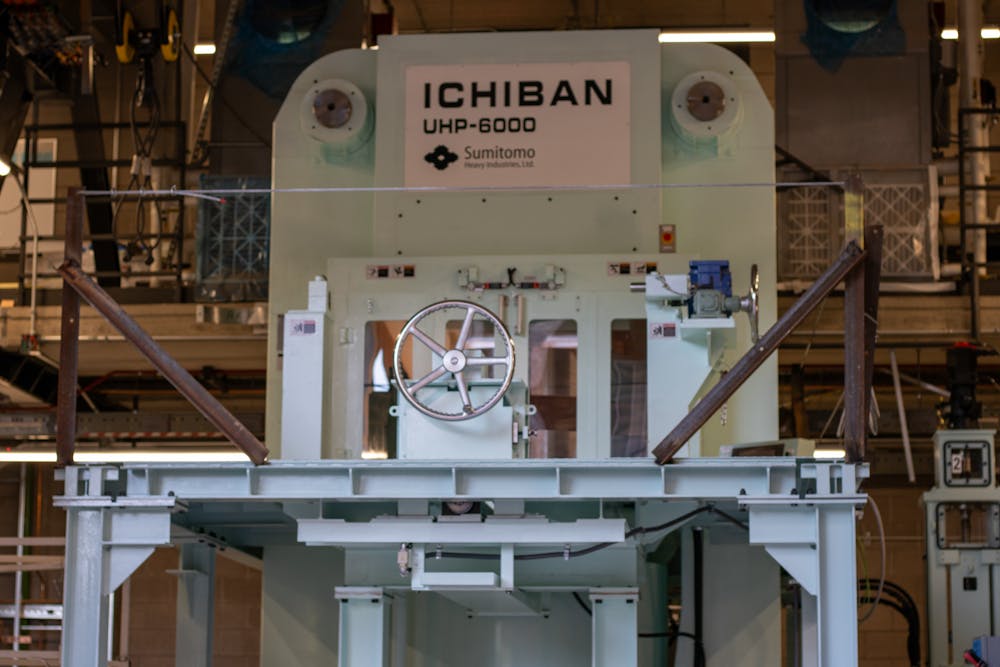The Facilities for Open Research in a Compressed Environment Lab at ASU is a groundbreaking facility dedicated to high-pressure research and revolutionizing knowledge of material behaviors under extreme conditions. Construction of the lab was scheduled to be finished on Oct. 1, and experiments are set to begin as soon as next summer.
The FORCE Lab is committed to open access, inviting global experts to collaborate and leverage its state-of-the-art equipment. This inclusive mission, coupled with cutting-edge technology, propels the lab into a realm of endless possibilities, promising discoveries that could reshape our understanding of the natural world.
Kurt Leinenweber is a principal investigator and research professor in the School of Molecular Sciences.
"It's going to be an open facility that people can come to do high-pressure research," Leinenweber said. "And the reason we had to do it that way is because the equipment is so big. And so this is equipment that didn't exist in our hemisphere yet now does."
Researchers can collaborate not only with other scientists within ASU but also with external institutions and facilities. By partnering with synchrotrons, which conduct crystallography and material science experiments, scientists can analyze the materials they are synthesizing.
"ASU has a lot of amazing resources, especially in materials characterization," said Thomas Sharp, an associate director of the Arizona Space Grant Consortium and professor at the School of Earth and Space Exploration. "We have some of the best electron microscopes in the world, and other facilities."
This open-ended approach to collaboration fosters an environment of exploration and discovery.
"We kind of know what to expect, because we know our field. But there might also be some surprises that we don't see coming," Leinenweber said.
The primary focus of the FORCE Lab is high-pressure research, and to conduct this, it houses four state-of-the-art pieces of equipment designed to subject materials to extreme pressures.
"The measurements that we will have available are going to be mainly electrical conductivity of the sample that is under pressure. And also ultrasonic ... like basically, compression and shear wave velocity in the sample," Leinenweber said.
High-pressure conditions induce profound changes in atomic structures and material properties, and this research is invaluable for exploring chemistry, physics and material synthesis.
Alexandra Navrotsky, professor at the School of Molecular Sciences and the School for Engineering of Matter, Transport and Energy, is also one of the principal investigators of the facility.
"When you (pressurize) something, you bring the atoms closer together. When you bring the atoms closer together, they interact more strongly and differently with each other," Navrotsky said.
Historically, high-pressure research has led to groundbreaking discoveries with commercial implications. Similarly, the FORCE Lab's work may similarly uncover valuable discoveries with applications in various industries.
"Something like 70 to 80 years ago, diamond was a curiosity. And now, when we make diamond at high pressure, and also under some cases, at atmospheric pressure, things like industrial diamond are very cheap," Navrotsky said.
Another application of this research is extraterrestrial. The interiors of planets, including Earth, are characterized by high-pressure and temperature conditions. By simulating these extreme environments, researchers gain insights into planetary formation, evolution, and potential habitability.
"If we want to understand how a planet like the Earth, or the many exoplanets we are now finding, how they formed, how they evolve, what will happen to them, what will happen to us, we need to understand what happens to materials, particularly materials of compositions," Navrotsky said.
This planetary perspective has the ability to expand the understanding of not only Earth, but also the myriad of exoplanets discovered beyond our solar system.
"I'm interested in what happens really early in a planet's history when the entire surface is molten of a big magma ocean." Kara Brugman, a research scientist for the Eyring Materials Center at ASU, said.
The FORCE Lab's commitment to open collaboration and innovation transcends boundaries, uniting diverse minds in a shared pursuit of knowledge. With pioneering equipment and a multifaceted approach spanning planetary science, materials research and more, the lab holds the potential to unlock secrets that have eluded humanity for centuries.
Edited by River Graziano, Jasmine Kabiri and Sadie Buggle.
Reach the reporter at dmanatou@asu.edu.
Like The State Press on Facebook and follow @statepress on X.
Dimitra is a junior studying biomedical engineering and physics. This is her second semester with The State Press. She has also worked as a research assistant in Kirian Lab.




